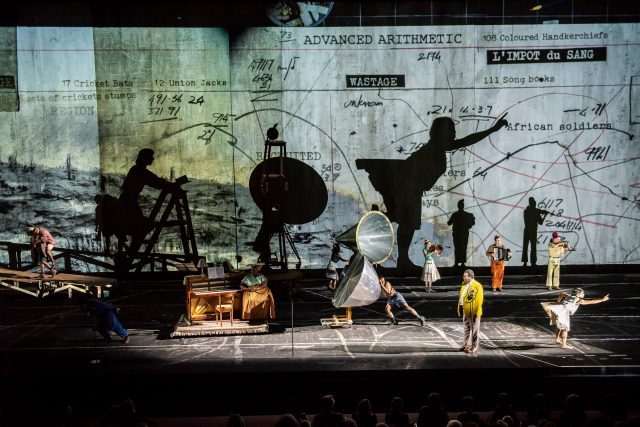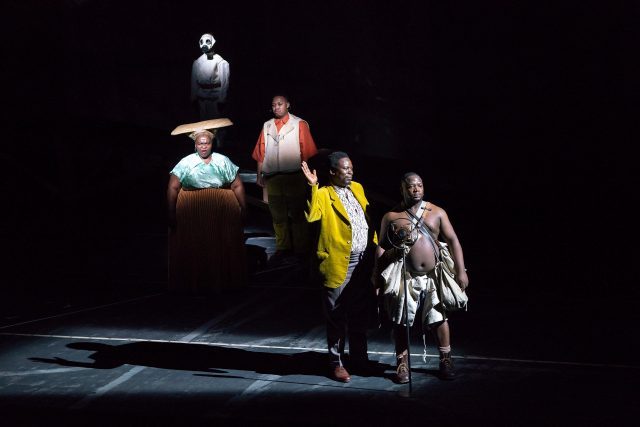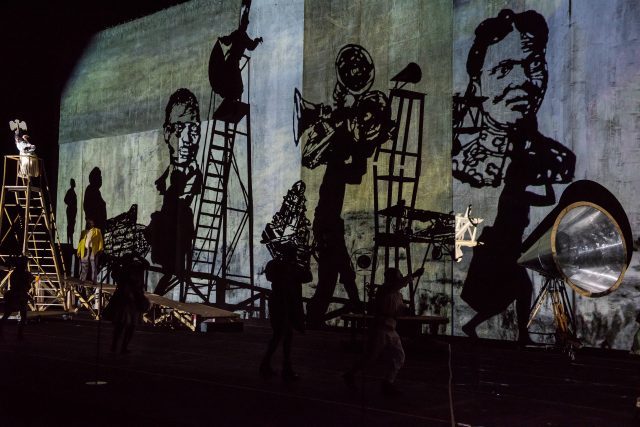
William Kentridge’s massive spectacle The Head & the Load continues at Park Avenue Armory through December 15 (photo by Stephanie Berger)
Park Avenue Armory, Wade Thompson Drill Hall
643 Park Ave. at 67th St.
December 4-15, $40-$90, 2:00/7:00/8:00
212-933-5812
armoryonpark.org
www.theheadandtheload.com
In 2012, MoMA hosted “Five Themes,” a major, wide-ranging retrospective of the work of South African artist William Kentridge. Virtually everything Kentridge has done since then — the public procession Triumph and Laments: A Project for Rome, the multimedia chamber opera Refuse the Hour, adaptations of Berg’s Lulu and Shostakovich’s The Nose at the Met, “The Refusal of Time” installation at the Metropolitan Museum of Art, the gallery exhibition “Second-Hand Reading” at Marian Goodman, and a performance of Kurt Schwitters’s Ursonate at Harlem Parish — has merely been a prelude to The Head & the Load, a massive multidisciplinary spectacle that could only be put on in New York City in the Park Avenue Armory’s Wade Thompson Drill Hall. Taking place on a stage nearly two hundred feet long, the presentation employs a jagged, abstract narrative to explore the fate of hundreds of thousands of black Africans forced into service by colonialist European countries, primarily Germany, France, Belgium, and Britain, as porters and carriers during World War I. Kentridge uses live music, choreographed movement, video projections, and dialogue in multiple languages to relate the tragic tale. A trio of military men (Hamilton Dlamini, Nhlanhla Mahlangu, and associate director Luc De Wit) speak in nonsense words from Ursonate. Ann Masina delivers gorgeous arias with objects on her head. Joanna Dudley, wearing an eagle on a Nazi helmet, is pushed across the stage on a ramshackle cart, pronouncing edicts. Sipho Seroto stands atop a tower, wearing an evil-looking gas mask. The Knights play in a surprise confined space. Mncedisi Shabangu, in a bright yellow jacket, serves as narrator, guiding us through the complex story. A procession of men and women parades across the length of the stage, many wearing or carrying stencil cutouts of human faces and animals that show up as silhouetted shadows on the back wall, mixing with previously photographed video.

Ann Masina sings as four men look on in The Head & the Load (photo by Stephanie Berger)
In a program note, Kentridge asks, “Can one find the truth in the fragmented and incomplete? Can one think about history as collage, rather than as narrative?” Commissioned by 14-18 NOW and the armory along with Ruhrtriennale and MASS MoCA as part of the centenary of the end of WWI, The Head & the Load is a thrilling eighty-five-minute cacophony of sound, images, and movement, a performance collage that reveals little-known facts about African involvement in the war. The title comes from the Ghanaian proverb “The head and the load are the troubles of the neck,” representing the physical and psychological burdens thrust onto Africans. The production is divided into three acts, “Manifestos,” “Paradox,” and “War,” with such scenes as “Morsecode / Swahili Phrasebook,” “Orders & Commands,” “Troubles of the Body,” “Playing Against History,” “Kaiser Waltz,” and “Coda & Deathlist.” Composers Philip Miller and Thuthuka Sibisi’s score was inspired by Maurice Ravel, Erik Satie, Paul Hindemuthy, Arnold Schoenberg, and Fritz Kreisler, while Kentridge incorporates text, either spoken or projected onscreen, from Frantz Fanon, Tristan Tzara, Wilfred Owen, Aimé Césaire, the conference of Berlin, phrases from a handbook of military drills, Setswana proverbs from Sol Plaatje’s 1920 collection, and a letter from John Chilembwe.

The Head & the Load is highlighted by a multimedia procession across a two-hundred-foot-long stage (photo by Stephanie Berger)
The choreographer is Gregory Maqoma, with cinematography by Duško Marović, costumes by Greta Goiris, sets by Sabine Theunissen, lighting by Urs Schönebaum, and sound by Mark Grey, all coming together in exciting ways. Although Kentridge himself does not appear, his hands are evident throughout, particularly when cutting up maps and other documents on filmed segments, evoking the feel of the entire piece, which is really more of an experience than a show. When the audience enters the drill hall, they pass by several lights that project their shadows onto the back wall of the stage, a sly way of making everyone complicit in this colonialist world of war, ethnocentricity, and cultural suppression. It’s a critical message for the modern era, sent by an extraordinary artist and his marvelous team.